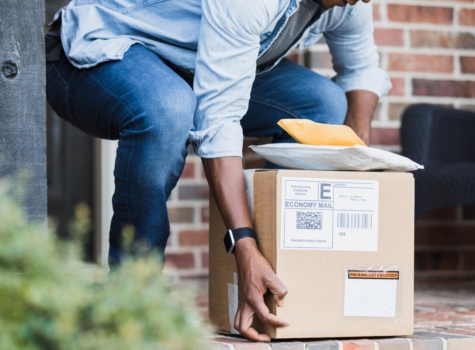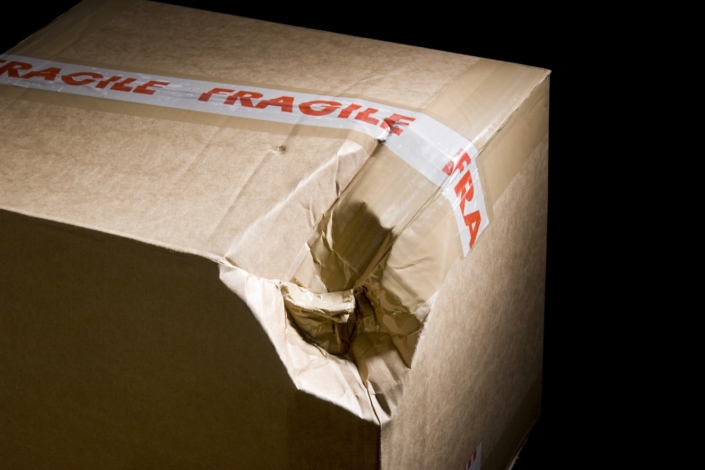Your customer calls in a panic. “My package was supposed to arrive yesterday, but it never showed up. What’s going on?”
The shopper’s shipment has likely been marked as a delivery exception. What does delivery exception mean, and how should your business react? In this article, you’ll find answers to both questions.
What is a delivery exception?
A delivery exception is when a package is temporarily delayed due to an unexpected event such as a natural disaster, incorrect address, or damaged shipping label.
Does every package with a delivery exception status arrive late? Not necessarily. Although this delivery status sometimes means that a package will arrive after the estimated delivery date, carriers often make adjustments (like re-routing a package so it doesn’t have to travel through a storm) and complete the delivery on time.
Occasionally, the package won’t make it to the recipient at all—instead, the carrier will return it to your business.
What is a shipment exception?
The terms shipment exception and delivery exception mean the same thing; they’re simply different ways of referring to unexpected events that delay a package while it’s en route to its end destination.
FedEx, UPS, and USPS delivery exceptions
If you’re shipping with one (or more) of the three major carriers in the U.S., you might wonder how they each handle delivery exceptions.
- FedEx delivery exceptions. The FedEx website lists a few common causes of delivery exceptions, such as extreme weather, and states, “We work hard to deliver every package as soon as possible, so a delivery exception doesn’t necessarily mean your shipment will arrive late.” You can find more information on FedEx’s tracking statuses here.
- UPS delivery exceptions. On UPS’s tracking status page, they note that when there’s a delivery exception, “The reason for the exception will be noted in the Shipment Progress section of the Tracking Detail page. When the delivery date changes, the tracking status will show the new date.”
- USPS delivery exceptions. USPS delivery exceptions are common on or around federal holidays. Customers can learn more about specific reasons for delivery exceptions on USPS’s tracking status page.
Why are delivery exceptions harmful?
Delivery exceptions might not seem like a big deal, but they can upset current customers, prevent you from attracting new ones, and decrease profit margins.
- Upset customers. As mentioned earlier, not every delivery exception results in a late delivery. However, even a handful of late packages can hurt your business. Customers who are eagerly anticipating their package will be disappointed at best and angry at worst when it doesn’t show up. They might even decide to never buy from your brand again.
- Damaged reputation. Those angry customers described above? They have friends, both online and offline. And they won’t hesitate to badmouth your business if they have a bad experience. They could also leave negative reviews that discourage potential customers from going through with a purchase.
- Wasted resources. Even worse, what if a package gets returned to sender? Not only will the shopper be angry (and rightly so), but you’ll have to pay to re-ship the package. Those extra costs will eat into your profits, which can have a major impact on a small business over time.
Long story short: to protect your reputation and retain customers, you need to minimize delivery exceptions—and that starts with understanding what causes them in the first place.
Seven common causes of delivery exceptions
By understanding what causes delivery exceptions, you’ll be able to reassure frustrated customers and optimize your parcel shipping in the future. Delivery exceptions can result from issues with packages, delivery addresses, transportation, and more.
1. Address issues or inaccessible locations
Wrong or incomplete addresses are a major reason for delivery exceptions. A single typo in an address can lead carriers to a location that doesn’t accept deliveries (think: empty lot) or doesn’t exist at all.
Other times, addresses are correct, but they’re gated or otherwise hard to reach. Even animals can cause trouble. For example, delivery drivers might feel unsafe approaching a porch if a snarling dog is tied up in the yard.
2. Damaged or missing labels
Missing or damaged labels and unreadable barcodes slow down package sorting and often prevent carriers from completing deliveries. If the carrier damages the label, they’ll probably refund you because of their delivery guarantee. But if your own sloppiness causes a label to tear or smudge, you’ll be responsible for the cost of re-shipping the package.
3. Bad weather or natural disasters
Any kind of weather or natural disaster that shuts down roads or airports—snow, rain, hail, hurricanes, wildfires, and more—can result in transportation delays that cause packages to be marked with a delivery exception status.
Fortunately, carriers often re-route shipments away from affected areas, ensuring they’re still delivered on time.
4. No one is available to receive the package
Packages that contain valuables, such as electronics or jewelry, usually require a signature upon delivery. The same thing goes for age-restricted items like alcohol or firearms. If nobody is home to sign for a package when the carrier arrives, the driver will attempt delivery at another time. If a package can’t be successfully delivered, it will be returned to your business.
5. Missing documentation
When packages are missing documentation, they can get held up. This is most common when shipping internationally, as packages need certain paperwork to clear customs. If the forms are incomplete or incorrect, customs will hold the package longer than expected.
6. Holidays
Carriers often shut down or limit operations on holidays. If you ship too close to a holiday, your package might end up stuck in a sorting center for longer than you expected, which could change its estimated arrival date.
Find a list of holidays observed by USPS, UPS, and FedEx here.
7. Other carrier issues
While rare, carriers sometimes face other unexpected issues that slow operations. Trucks might break down mid-route, or sorting errors could send packages off course. If a driver falls too far behind on their daily route, they might have to deliver the rest of their parcels the next day, meaning all of those packages will be classified as delivery exceptions.
Preventing delivery exceptions
Now that we’ve explored the causes of delivery exceptions, let’s take a look at some solutions. While things like the weather are out of your control, you can still take steps to reduce issues and keep customers in the loop.
Verify delivery addresses
Something as simple as a single wrong number in a zip code or a misspelled street name can lead to a delivery exception. While carriers sometimes catch incorrect addresses themselves, they’ll charge your business a fee each time—ouch! And if something slips through the cracks, and a package gets returned to sender, customers will expect you to pay to re-ship it.
Fortunately, the solution is simple: use address verification software (AVS). These programs use a country’s address database to ensure that shoppers enter correct, deliverable addresses during the checkout process. If a ZIP code doesn’t match a street address, an address isn’t formatted properly, or an address isn’t a deliverable location, the software will prompt the shopper to correct it.
The result? Fewer delays and failed deliveries.
Ship with multiple carriers
Your business doesn’t have direct control over shipping once you’ve handed packages over to a carrier. You don’t get to choose whether they route the packages to avoid inclement weather or keep their vehicles serviced to avoid breakdowns. But you do get to choose which carriers you use.
By keeping a careful eye on your parcel shipping data, you can get a sense of which carriers perform the best, as well as which ones tend to have more delivery exceptions. With multiple carriers in your shipping arsenal, you’ll have the flexibility to choose the ones that are most likely to complete deliveries on time.
To avoid the hassle of manually integrating with multiple carriers, try using a multi-carrier shipping API like EasyPost. Offering over one hundred national, regional, and international carriers, EasyPost makes it simple to find the best fit for every package you send.
Use weather-resistant labels, and attach them properly
If you’re concerned that labels will become unreadable due to damage from rain or snow, consider investing in weather-resistant labels.
Another easy way to decrease the chances of label damage? Secure labels to boxes using strong tape that covers every edge of the label. Make sure each label is flat, not creasing over the edge of the box.
Provide tracking pages and send shipping notifications
Several of the issues described above deal with things that customers control. For example, a carrier might be prevented from delivering a package for one of the following reasons:
- No one is home to sign for it.
- The house is surrounded by a fence with a locked gate.
- An aggressive dog is roaming the yard.
Package tracking helps solve problems like this. When someone knows exactly when to expect their shipment, they can plan to be home to receive it, make sure to unlock the gate, or bring animals inside.
But what about when a delivery exception happens because of something neither you nor the customer can control?
Tracking and notifications still help in these scenarios, allowing customers to adjust to potential changes in their expected delivery date. When they can track their package from start to finish, they’re less likely to stress out when things don’t go according to plan. That means fewer calls to your customer service team and fewer bad reviews.
Get branded, real-time, multi-carrier tracking
As your shipping volume scales, managing shipping manually uses up valuable time and resources that could be focused on other areas of your business. When it comes to delivery exceptions, automating a few key processes with technology makes all the difference.
The EasyPost suite of shipping APIs offers solutions to help you catch shipping issues before they happen and resolve them quickly when necessary.
Multi-carrier support through one API
Companies of all sizes use EasyPost to ship with USPS, UPS, FedEx, DHL, and many more large, regional, and national carriers. Managing all of your shipments from one place gives you more control, ensuring that if a certain carrier experiences issues, you can quickly transfer volume to others.
While shipping reliability is a huge perk of a diverse carrier lineup, it’s not the only one. Once a business has integrated with multiple carriers, they can rate shop to find the cheapest shipping costs for every package.
Branded tracking pages
Some companies send their customers to the carrier’s tracking website to follow their package’s progress. While this works just fine, it doesn’t exactly make for an excellent post-purchase experience.
A better option? Send your customers to a custom-branded tracking page that keeps your business front and center. The EasyPost Tracking API makes it simple to do just that, letting you own the customer experience long after the customer has clicked “Check Out.”
Real-time updates
In addition to a branded tracking page, the Tracking API also gives you access to tracking webhooks that automatically send notifications as packages move.
Included at no extra cost
Once you’ve set up the EasyPost Shipping API (which is free for businesses shipping up to 3,000 packages per month), you’ll have full access to tracking features. No added fees and no long onboarding process—just reliable, real-time tracking for you and your customers.
Keep all your shipments on track with EasyPost
Delivery exceptions can be stressful, but with a solid fulfillment strategy and the right shipping technology, you can keep the majority of your packages on track. And when a package does get delayed, lost, or returned to sender, you can quickly find a solution instead of scrambling to uncover the problem.
EasyPost offers a variety of tools to make shipping simple, reliable, and affordable. If you could benefit from access to an extensive carrier library, robust tracking features, advanced rate shopping, and automatic label generation (and let’s be honest, who couldn’t?), sign up for free to give it a try.




